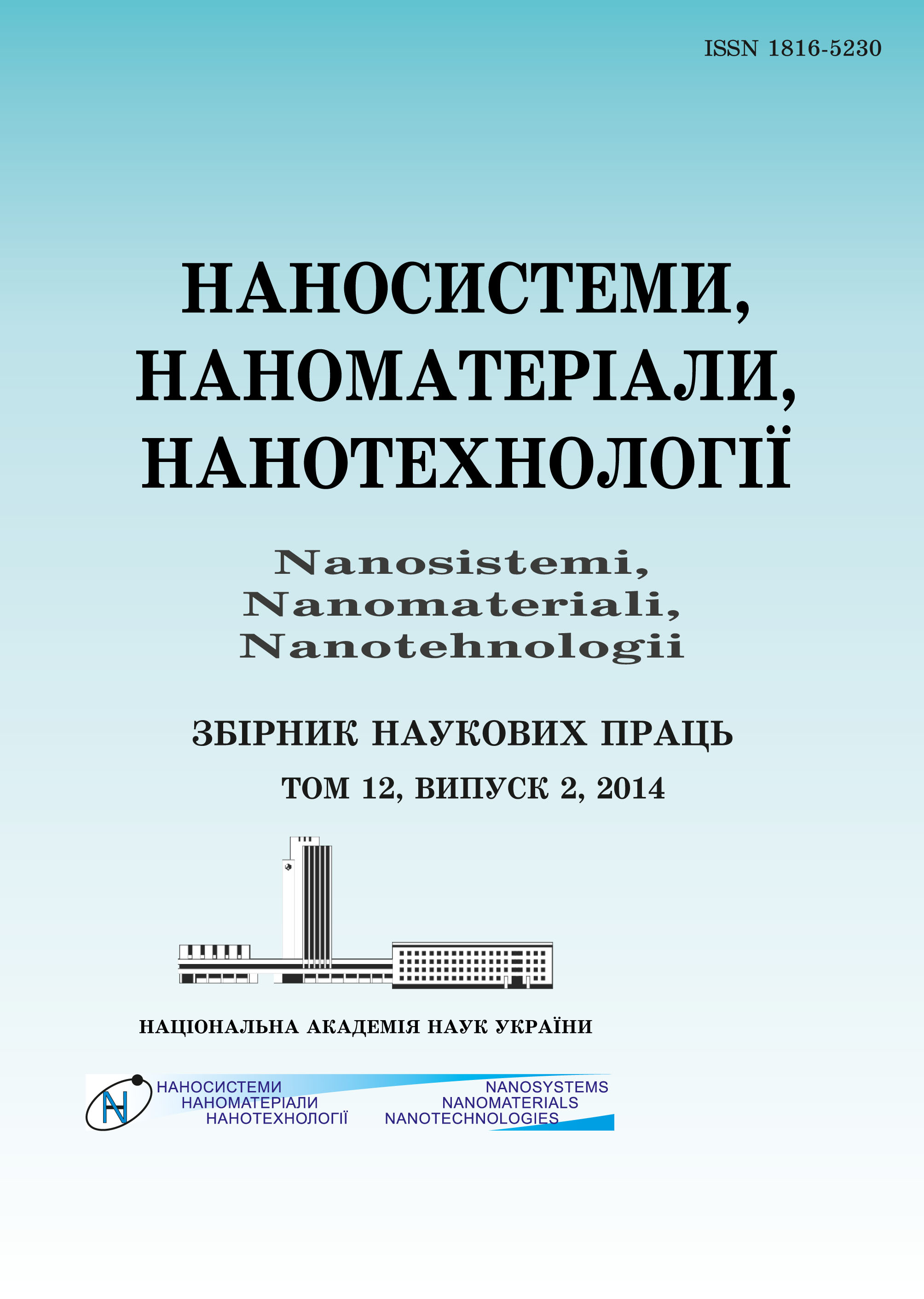|
|
|||||||||
 |
Year 2021 Volume 19, Issue 1 |
|
|||||||
|
|||||||||
Issues/2021/vol. 19 /Issue 1 |
D. Starokadomskyy, Ye. Voronin, M. Reshetnyk, N. Siharyova, S. Shulha, N. Havrylyuk, L. Kokhtych,, O. Starokadoms'ka, S. Vyshnevskyy, S. Hrebenyuk, Yu. Danchenko
«Morphology, Strength, Thermal and Chemical Stability of Epoxy Resin-Based Nanosystems with Pyrogenic Nanosilica A-300 and Its Compacted Analogue ‘Densil’ (with Original and Modified Surface)»
0071–0090 (2021)
PACS numbers: 62.23.Pq, 68.37.Hk, 68.37.Ps, 68.55.J-, 81.05.Lg, 81.70.Pg, 82.35.Np
Compositions of epoxy resin with pyrogenic ‘Aerosil A300’-type nanosilica in its unmodified, compacted (‘Densil’) and surface-modified with silver iodide forms have been experimentally investigated. ‘Densil’ has been shown to have several times lower densification capacity (at 31–33 wt.%; for A300, it is of 12 wt.%). At the same time, it usually does not reduce the strength characteristics of the polymer epoxy composite. Moreover, in some cases, they are strengthened (adhesion, strength and elastic modulus in bending, elastic modulus in compression, and resistance in high vacuum). Microscopy revealed significant differences in the morphology of the composites with A-300 and ‘Densil’. They are manifested in a more even distribution of ‘Densil’ that is expressed in smaller quantities and smaller agglomerates. As shown, the resistance to thermooxidative degradation does not change with the addition of ‘Densil’, but increases with the addition of nanosilica A-300 or ‘Densil’ + AgJ. The introduction of ‘Densil’ and ‘Densil’ + AgJ increases the resistance to swelling and degradation in an aggressive acetone solvent, while the silica A-300 does not change it. The results of the experiments indicate the promising technology for fabrication of nanomaterials with silica A-300 and ‘Densil’ to create coatings, adhesives or compounds for industrial restoration needs.
Keywords: epoxy composite, A-300 nanosilica, ‘Densil’, compressive strength, bending strength, adhesion to steel, elastic modulus, resistance to thermal degradation, swelling
https://doi.org/10.15407/nnn.19.01.071
References
1. D. Starokadomsky, A. Tkachenko, and I. Garashhenko, Plasticheskie Massy,Nos. 5–6: 50 (2015) (in Russian).2. D. L. Starokadomsky and I. G. Telegeev, Open Journal of Polymer Chemis-try, 2: 117 (2012); https://doi.org/10.4236/ojpchem.2012.23016
3. D. L. Starokadomsky, N. Sigarjova, A. I. Tkachenko, Ju. Shevljakov,I. Garashchenko, and A. Tkachenko, Plasticheskie Massy, 9: 42 (2013) (inRussian).
4. D. L. Starokadomsky, Zhurnal Prikladnoy Khimii, 81, No. 12: 2045 (2008)(in Russian).
5. D. Starokadomsky and T. Solovieva, Russ. J. Appl. Chem., 75, No. 1: 138(2002).
6. D. L. Starokadomsky and I. G. Telegeev, Nanotekhnika, 27, No. 3: 39 (2012)(in Russian); https://www.nanotech.ru
7. D. L. Starokadomsky, I. G. Telegeev, and S. V. Golovan’, PlasticheskieMassy, No. 7: 35 (2010) (in Russian).
8. D. L. Starokadomsky, Khimichna Promyslovist Ukrainy, 5: 52 (2011) (inRussian).
9. D. Starokadomsky, Journal of Materials Science and Engineering, 1, No. 3:436 (2011); D. Starokadomsky, Plasticheskie Massy, No. 2: 33 (2008) (inRussian).
10. A. P. Petrova, Je. K. Kondrashov, and Ju. V. Korotkov, Skleivanie Instru-menta i Osnastki v Mashinostroenii [Bonding Tools and Accessories in Me-chanical Engineering] (Moscow: Mashinostroenie: 1987) (in Russian).
11. A. Taylor, A. Kinloch, K. Ìasania, R. Mohammed, and S. Sprenger, Conf.Paper ‘Toughness of Nanopàrtice-Modified Epoxy and Fibre Composites’(2016), p. 9; https://www.researchgate.net/publication/327802257
12. F. J. Guild, A. J. Kinloch, K. Masania, S. Sprenger, and A. C. Taylor,Strength, Fracture and Complexity, 11, Nos. 2–3: 137 (2018); ÌÎÐOÎËÎòß, ̲ÖͲÑÒÜ, ÒÅÐÌÎ- ÒÀ ÕÅ̲×ÍÀ ÑÒ²ÉʲÑÒÜ ÍÀÍÎÑÈÑÒÅÌ 89 https://doi.org/10.3233/SFC-180219
13. Z. Naghizadeh, M. Faezipour, M. H. Pol, G. H. Liaghat, and A. Abdolkhani,J. Materials: Design and Applicaions, 232, Iss. 9: 785 (2016); https://doi.org/10.1177/1464420716649403
14. A. Kocijan, M. Conradi, and M. Zorko, Materials and Technology, 46, No.6: 657 (2012).
15. M. M. Nikje, M. Khanmohammadi, A. Garmarudi, and M. Haghshenas, Cur-rent Chemistry Letters, 1, No. 1: 13 (2012); https://doi.org/10.5267/j.ccl.2011.12.002
16. A. S. Mostovoi, E. V. Plakunova, and L. G. Panova, International PolymerScience and Technology, 40, Iss. 7: 49 (2013); https://doi.org/10.1177/0307174X1304000711
17. A. S. Mostovoy, A. S. Nurtazina, I. N. Burmistrov, and Y. A. Kadykova,Russian Journal of Applied Chemistry, 91: 1758 (2018); https://doi.org/10.1134/S1070427218110046
18. V. M. Gun’ko, E. F. Voronin, L. V. Nosach, E. M. Pakhlov, N. V. Guzenko,R. Leboda, and J. Skubiszewska-Zieba, Adsorption Science & Technology, 24,No. 2: 143 (2006); https://doi.org/10.1260/026361706778529173
19. Yu. S. Zuev, Razrushenie Polimerov pod Deystviem Agressivnykh Sred [De-struction of Polymers under the Influence of Aggressive Media] (Moscow:Khimiya: 1972) (in Russian).
20. T. A. Brusentseva, A. A. Filippov, and V. M. Fomin, Izvestiya of AltayState University Journal, No. 1-1 (81): 25 (2014) (in Russian); http://izvestia.asu.ru/media/files/issue/5/articles/ru/25-27.pdf,DOI 10.14258/izvasu(2014)1.1-04
21. O.O. Daramola and O. S. Akintayo, International Journal of Engineering ,XV, No. 4: 167 (2017);www.researchgate.net/publication/327551546_Mechanical
22. M. Amin, M. Ali, and A. Khattak. Science and Engineering of CompositeMaterials, 25, No. 4: 753 (2018); https://doi.org/10.1515/secm-2015-0445
23. Z. Naghizadeh, M. Faezipour, M. H. Pol, G. H. Liaghat, and A. Abdolkhani,J. Materials: Design and Applicaions, 232, Iss. 9: 785 (2016); https://doi.org/10.1177/1464420716649403
24. H. Mahfuz et al., Nanotechnology (IOP Publishing Ltd), 19: 445702-1(2008); http://iopscience.iop.org/0957-4484/19/44/445702
25. I. Ìàlahova, V. Òeortych, Yu. Bolbukh, and Î. Shyjchuk, Polymer Journal,29, No. 2: 149 (2007).
26. AEROSIL® Fumed Silica for T Solvent-Free Epoxy Resins (Technical Bulle-tin Fine Particles 27) (Hanau, Germany: Evonik Industries AG InorganicMaterials: 2013).
27. Antikorrozionnyye i Ognezashchitnyye Svoystva Ehpoksidno-Kremnezemnykhi Ehpoksidno-Titanoksidnykh Kompozitsionnykh Pokrytiy (2000–2017 gg.)[Anticorrosion and Fire Retardant Properties of Epoxy–Silica and Epoxy–Titanium Oxide Composite Coatings (2000–2017)] (Eds. L. A. Gnibed, V. M.Mikhalchuk, and V. A. Krotov) (Donetsk: DonNU: 2018).
28. P. Dittanet, The Use of Nanosilica in Epoxy Resins (Thesis for the degree ofMaster of Sci.) (Lehigh, PA, USA: Lehigh University: 2008); https://core.ac.uk/download/pdf/228642342.pdf
29. D. L. Starokadomsky, Vplyv Vysokodyspersnykh Pirohennykh Kremnezemiv90 Ä. ÑÒÀÐÎÊÀÄÎÌÑÜÊÈÉ, ª. ÂÎÐÎͲÍ, Ì. ÐÅØÅÒÍÈÊ, Í. ѲÃÀÐÜÎÂÀ òà ³í.na Protsesy Fotopolimeryzatsiyi Olihoefirakrylativ ta VlastyvostiOderzhanykh Kompozytiv [Influence of Highly Dispersed Pyrogenic Silicason the Processes of Photopolymerization of Oligoetheracrylates and Proper-ties of the Obtained Composites] (Thesis of Disser. … for Cand. Chem. Sci.)(Kyiv: O. O. Chuyko Institute for Surface Chemistry, N.A.S.U.: 2004) (inUkrainian).
 This article is licensed under the Creative Commons Attribution-NoDerivatives 4.0 International License ©2003—2021 NANOSISTEMI, NANOMATERIALI, NANOTEHNOLOGII G. V. Kurdyumov Institute for Metal Physics of the National Academy of Sciences of Ukraine. E-mail: tatar@imp.kiev.ua Phones and address of the editorial office About the collection User agreement |